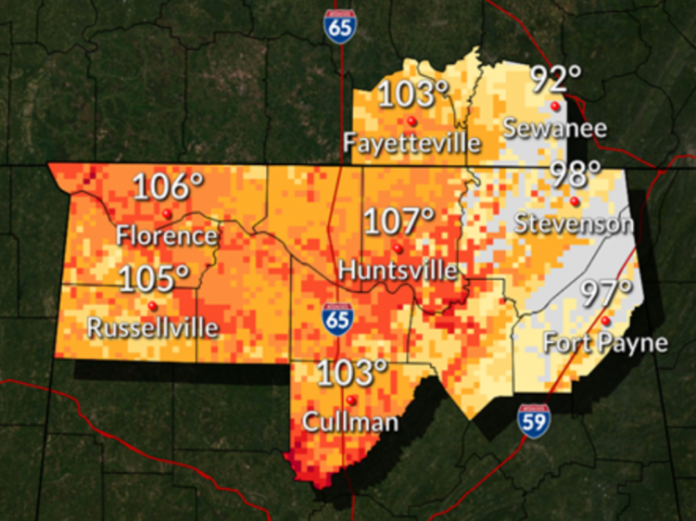MONTGOMERY, Ala. – State and federal agencies are warning residents across Alabama to be careful in current high heat conditions, which can be dangerous. Cullman saw a heat index of over 100 degrees Wednesday, and the National Weather Service Huntsville office reported, “Hot and humid conditions will continue on Thursday and a Heat Advisory is in effect for northwest and north central Alabama from 10 a.m. – 7 p.m. The dangerous heat will expand over the entire Tennessee Valley on Friday, with heat index values between 105 to 110 degrees being common across much of the area.”
In light of current conditions, the Alabama Department of Public Health issued this advisory on Wednesday:
With heat indices rising into triple digits, the Alabama Department of Public Health advises the public to be alert to the warning signs of heat illnesses. Heat-related illnesses occur when the body is exposed to high temperatures. The incidence of these illnesses rises expectedly during warm weather periods, and anyone exposed to high temperatures or extreme heat can experience symptoms when the body’s temperature control system is overloaded.
The most common heat-related illnesses are as follows:
- Heat cramps
- Heat exhaustion
- Heat stroke
Heat cramps– include muscle pains or spasms (abdomen, arms or legs), profuse sweat and high salt concentration in the sweat.
Heat exhaustion– is associated with heavy sweating, paleness, muscle cramps, tiredness, weakness, dizziness, headache, nausea or vomiting and fainting. Other possible symptoms may include cool and moist skin, fast and weak pulse rate, fast and shallow breathing or irritability. Older adults, those with high blood pressure and those working or exercising in a hot environment are prone to heat exhaustion. If heat exhaustion is not treated, it may progress to heatstroke.
Heat stroke or sun stroke – the most serious heat-related illness, a life-threatening problem, may occur when the body is unable to control its temperature. Body temperature may rise to 106 degrees F or higher within 10 -15 minutes. Signs include an extremely high body temperature, red, hot and dry or moist skin, rapid, strong pulse, throbbing headache, dizziness, nausea, dehydration, combativeness or confusion and unconsciousness. Heat stroke is a medical emergency and even with immediate treatment, it can be life-threatening or cause serious long-term problems.
It is recommended people drink plenty of fluids except alcohol or caffeinated beverages to prevent dehydration, stay in an air-conditioned room, keep out of the sun by seeking shelter, wear a wide-brimmed hat, light-colored and loose-fitting clothing, use sunscreen of SPF 15 or higher, take cool showers or baths and reduce or eliminate strenuous activities during the hottest times of the day.
Individuals with heart disease, diabetes, obesity, poor circulation, or previous stroke problems, people of older and younger ages and those taking certain medications are at greater risk of becoming ill in hot weather.
For more information, visit https://www.alabamapublichealth.gov/injuryprevention/heat.html.




















